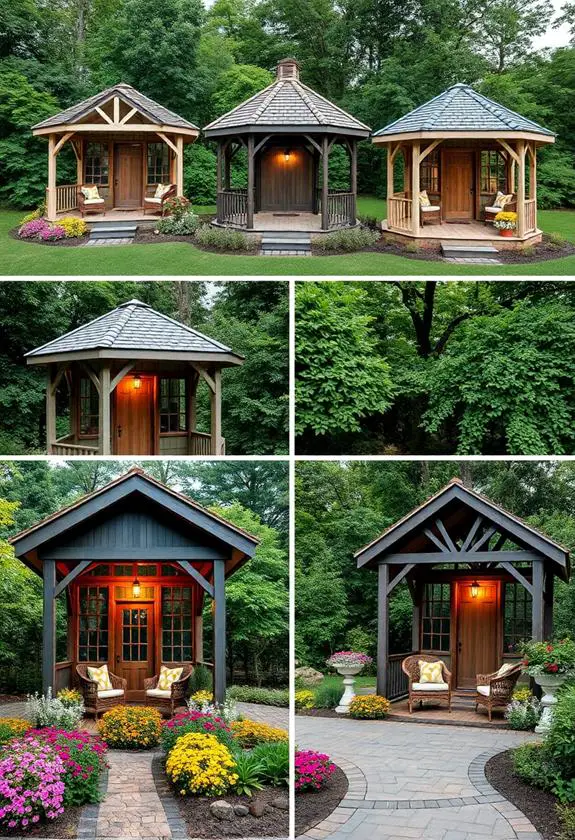Imagine enjoying a peaceful afternoon in your backyard gazebo when suddenly, a gust of wind threatens to lift it off the ground. This scenario is more common than you might think. Gazebos add charm and functionality to outdoor spaces, providing shade and a cozy spot for relaxation or entertaining. But can these beautiful structures really blow away? While it’s rare for properly anchored gazebos to completely blow away, strong winds can damage or move them if they’re not secured correctly.

Wind can be a gazebo’s worst enemy, especially for lightweight or portable models. The good news is that there are several ways to keep your gazebo firmly in place. From using stakes and sandbags to choosing the right location, you can take steps to protect your outdoor oasis from gusty weather.
Key Takeaways
- Gazebos can be at risk in strong winds if not properly secured
- Various anchoring methods can help keep gazebos in place
- Choosing the right location and gazebo type improves wind resistance
Factors Contributing to Gazebos Blowing Away
Wind speed is a big factor in whether your gazebo might blow away. Small gazebos can usually handle winds up to 20-25 mph. Larger ones may withstand up to 40 mph.
The materials used to build your gazebo matter too. Lightweight materials like vinyl are more likely to catch the wind. Heavy-duty materials like galvanized steel offer better wind resistance.
How you set up your gazebo is crucial. Proper anchoring is a must! Use stakes and tie-downs to keep it firmly in place. Adding weight plates can stop it from tipping over in strong gusts.
The shape of your gazebo affects how it handles wind. Open designs let air flow through, reducing pressure. Closed walls can act like sails, catching more wind.
Your location plays a role too. Gazebos in open areas face stronger winds than those sheltered by buildings or trees.
Weather changes can sneak up on you. Keep an eye on the forecast, especially for sudden wind warnings.
Temporary gazebos are more at risk than permanent ones. They’re often made of lighter materials and aren’t as securely anchored.
Remember, even sturdy gazebos can be damaged by extreme weather. Always prioritize safety when winds pick up!
Tips to Prevent Gazebos from Blowing Away
Keeping your gazebo firmly in place is crucial for safety and enjoyment. Here are some helpful tips to stop your gazebo from taking flight:
Use weights to anchor your gazebo. Sandbags, concrete blocks, or special gazebo weights can be placed on each leg. This extra weight helps keep it grounded during windy days.
Secure your gazebo with stakes and ropes. Drive stakes deep into the ground and tie strong ropes from the gazebo frame to these stakes. This method works well for both temporary and permanent structures.
Install an anchoring kit. These kits often include heavy-duty straps and concrete anchors. They provide a solid connection between your gazebo and the ground.
Add leg weights to your gazebo. You can buy purpose-made weights or use DIY options like filled water jugs. Attach them securely to each leg for added stability.
Use tie-down straps to secure your gazebo. Connect these straps from your gazebo to nearby sturdy objects like trees or fence posts. This gives extra support against strong winds.
Consider storm straps for extra protection. These special straps are designed to withstand high winds and severe weather. They’re a great option if you live in a storm-prone area.
Remember to check and tighten all anchors regularly. Wind can loosen connections over time, so stay on top of maintenance to keep your gazebo safe and secure.
Frequently Asked Questions
Many people worry about their gazebos blowing away in strong winds. Let’s look at some common questions about keeping gazebos secure and safe.
What is the best type of gazebo to withstand strong winds?
Gazebos with sturdy metal frames tend to hold up best in windy conditions. Look for models made of powder-coated steel or aluminum. These materials resist rust and provide excellent strength.
Avoid flimsy pop-up gazebos if you live in a windy area. Instead, choose a permanent or semi-permanent structure with thick support poles.
What are effective methods to secure a gazebo on concrete?
You can use heavy-duty anchor bolts to fasten your gazebo legs to a concrete patio or slab. Drill holes in the concrete, then insert expansion anchors.
Another option is to use concrete weights or sandbags. Place these on the feet of your gazebo for added stability.
How much wind is too much for a typical gazebo?
Most standard gazebos can handle winds up to about 20-25 mph. Beyond that, you may need to take extra steps to secure your structure.
If winds are forecast to exceed 30-35 mph, it’s best to take down soft-top gazebos or temporary models. Permanent gazebos should be fine in higher winds if properly anchored.
Are there any heavy-duty gazebos designed to be windproof?
Yes, some gazebo makers offer models built to withstand high winds. These often have reinforced frames, thicker support posts, and special wind-resistant canopies.
Look for gazebos rated for winds of 50 mph or more. They may cost more, but they’ll give you peace of mind in stormy weather.





